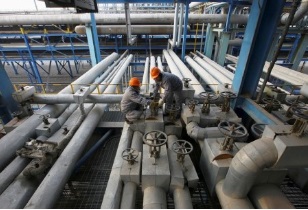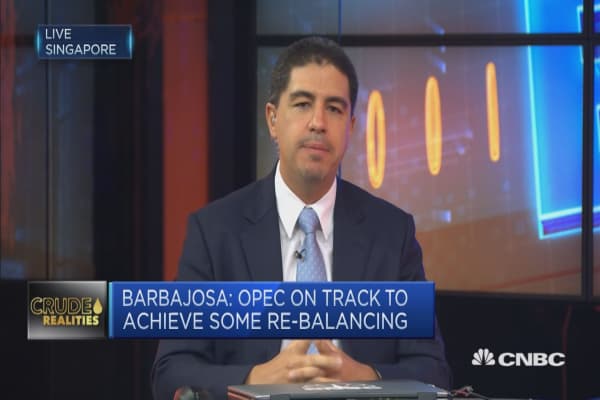Refinery demand, not OPEC, is the key to keeping oil prices above $50 a barrel, analysts say – Refinery demand OPEC oil prices Dollars 50 barrel - Arhive
Refinery demand OPEC oil prices Dollars 50 barrel Refinery demand OPEC oil prices Dollars 50 barrel Refinery demand OPEC oil prices Dollars 50 barrel Refinery demand OPEC oil prices Dollars 50 barrel Refinery demand OPEC oil prices Dollars 50 barrel
Refinery demand, not OPEC, is the key to keeping oil prices above $50 a barrel, analysts say
- Oil exporters meet in Vienna on Friday to discuss their agreement to cut output.
- Analysts say they are more focused on the demand outlook, which has grown stronger.
- Sustained high demand at refineries is the key to keeping an oil price rally going, they say.
 OPEC should be happy, 2017 seen phenomenal demand: Energy Aspects
OPEC should be happy, 2017 seen phenomenal demand: Energy AspectsOil exporters meet in Vienna on Friday to discuss their pact to cut production, but many analysts are not focused on Austria this week. Instead, they’re watching refineries around the world for signs that the oil price rally can continue.
U.S. West Texas Intermediate crude hit a nearly four-month high at $50.81 on Thursday, despite three straight weeks of rising stockpiles in the aftermath of Hurricane Harvey, which shut a quarter of U.S. refining capacity. On Friday, international benchmark Brent crude oil was trading within $2 of its 2017 high of $58.37.
This comes as the market focus has flipped from how quickly OPEC can drain a global glut of crude oil to how hungry the world remains for fuel. A major catalyst for the recent run-up was improved forecasts for 2017 global demand from the International Energy Agency and OPEC.
“There are times like these when [refiners will] push the envelope, especially when the envelope is getting stuffed with cash.”
Now, there are signs three years of oversupply are coming to an end.
Brent has flipped into backwardation, meaning prices for immediate delivery are higher than contracts for future shipment. That is a sign traders believe the market is tightening. It also helps to empty stockpiles by encouraging traders to sell oil immediately, instead of storing it to take advantage of higher prices in the future.
Brent crude price curve, source: Factset
Crude stockpiles have fallen in the OECD, a group of mostly developed nations, throughout the second quarter, OPEC notes in its September bulletin. OECD inventories stood at 195 million barrels above the five-year average in July, down from about 340 million barrels above that level at the start of 2017.
OPEC highlights the role of its production cuts in driving down stocks in the bulletin. The group, along with other exporters, is keeping 1.8 million barrels off the market through March. Friday’s producer meeting ended without the group agreeing to extend the cuts, Reuters reported.
“Over the first half of the year, the collective efforts of participating producer nations have pulled close to 350 [million barrels] in aggregate from global supply,” OPEC said. “It is easy to imagine what the market would have looked like had these 24 countries not taken such collective action.”
But OPEC may be giving itself too much credit, according to Matt Smith, director of commodity research at tanker-tracking firm ClipperData. While the cartel and its allies continue to keep a lid on production, their crude exports remain robust, with the exception of Saudi Arabia, he said.
Given that constant, the variable that matters for oil prices is demand, Smith said.
U.S. crude prices, year to date, source: Factset
“We haven’t really seen a number of OPEC [members] dialing back on their exports. For this momentum to be upset, it would have to come from the demand side,” he said.
U.S. refineries are processing about a million barrels a day less oil than at this time last year due to impacts from Harvey. However, crack spreads — the difference between crude oil and refined product prices — remain wide. That gives refiners a reason to keep processing crude at a time when they’re normally winding down operations to perform maintenance on their facilities.
Refiners may put off some maintenance and keep plants running so they can continue to take advantage of fat profit margins, sustaining demand for feedstock crude oil, analysts said.
“There are times like these when they’ll push the envelope, especially when the envelope is getting stuffed with cash,” said John Kilduff, founding partner at energy hedge fund Again Capital.
Demand for refined petroleum products like diesel has been “remarkable,” but Kilduff believes persistently high U.S oil production will continue to exert downward pressure on crude prices. He is also wary of the prevailing narrative around demand strength.
“To the extent it falters, prices will get punished again. That’s really the key here,” he said.
To be sure, U.S. shale oil producers have played the part of the spoiler this year. When crude costs rise, they lock in higher prices for future delivery with buyers. That means they keep pumping today to fulfill those contracts, which makes it harder to reduce oversupply.
However, monthly figures show U.S. oil production flatlining recently, and even dipping in June, said Amrita Sen, chief oil analyst at research consultancy Energy Aspects.
“I think $50 was proving to be too low. Global oil demand growth has been close to 2 million barrels per day, and supplies aren’t growing anywhere close to that. So I think $50 just ended up being a price where there was too much demand, and that’s why we’re drawing way too much inventories now,” she told CNBC on Friday.
High demand for diesel and home heating fuel in particular means refineries are willing to pay more for crude oil, said Tom Kloza, global head of energy analysis at Oil Price Information Service. While recent hurricanes have wiped out demand for gasoline in recent weeks, demand for diesel is likely to remain strong as construction crews fire up heavy machinery to rebuild storm-ravaged areas, he noted.
“Those high margins translate into less resistance for crude oil prices that are a few dollars higher,” he said.
Refinery demand OPEC oil prices Dollars 50 barrel Refinery demand OPEC oil prices Dollars 50 barrel Refinery demand OPEC oil prices Dollars 50 barrel Refinery demand OPEC oil prices Dollars 50 barrel Refinery demand OPEC oil prices Dollars 50 barrel Refinery demand OPEC oil prices Dollars 50 barrel Refinery demand OPEC oil prices Dollars 50 barrel

